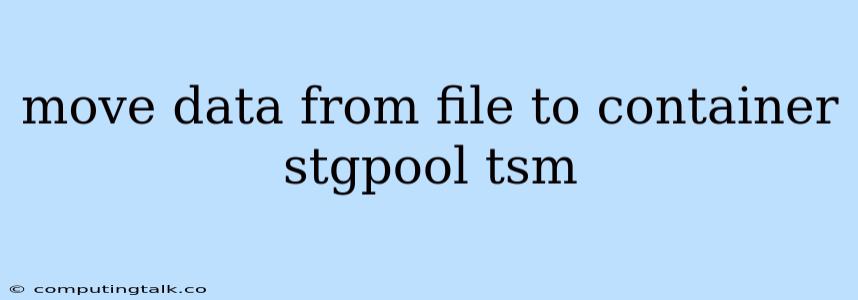Moving Data from File to Container: A Comprehensive Guide
The process of moving data from a file system to a container storage pool (stgpool) using TSM can be a crucial task in managing large datasets. It's often necessary to optimize storage, enhance data accessibility, and improve performance. This guide will provide a detailed explanation of the steps involved in this process, along with essential considerations and troubleshooting tips.
Understanding the Basics
Before diving into the technical aspects, let's understand the key components involved:
- Data File: This is the source of the data you want to move. It could be a single file or a collection of files in a specific directory.
- Container Storage Pool (stgpool): This is a logical grouping of storage devices in TSM. It serves as a centralized repository for your data, offering features like data compression, encryption, and backup capabilities.
- TSM: This stands for Tivoli Storage Manager, an enterprise-grade data protection and management solution. It provides tools and mechanisms for moving data between different storage locations, including file systems and stgpools.
Steps to Move Data from File to Container stgpool
Here's a detailed breakdown of the process:
-
Identify the Data Source:
- Precisely locate the data file or files that you intend to move.
- Ensure you have the necessary read permissions for the file(s).
-
Configure the stgpool:
- In your TSM administration console, navigate to the storage pool configuration.
- Verify the stgpool is active, has sufficient free space, and meets the requirements of your data.
-
Determine the Move Strategy:
- Incremental Move: This approach gradually moves portions of the data, reducing the impact on your file system. It's beneficial when dealing with large files or when you want to minimize disruption during the move process.
- Full Move: This method moves the entire file at once, potentially requiring more resources but achieving a faster transfer.
-
Execute the Move Command:
- TSM provides a command-line interface for initiating the move operation.
- A typical command structure might resemble this:
dsmadmc -id your_tsm_server_name move data_source_path container_stgpool_name - Replace the placeholders with your specific server name, data source path, and container stgpool name.
-
Monitor the Progress:
- Use TSM's monitoring tools to track the move operation's status.
- You can check the transfer rate, remaining data, and any potential errors encountered.
-
Verify the Results:
- After the move completes, ensure that the data has been successfully transferred to the stgpool.
- You can do this by accessing the stgpool and checking the presence of the moved files.
Tips and Best Practices
- Data Integrity: Ensure the integrity of the data before and after the move. Use checksums or other methods to validate the data.
- Space Considerations: Calculate the required space in the stgpool before initiating the move. Account for potential data compression or expansion during the transfer.
- Security: If you're dealing with sensitive data, implement appropriate security measures. Use strong passwords, encryption, and access control mechanisms.
- Backup: Before moving data, create a backup of the original data source. This provides a safety net if any issues arise during the move.
- Performance: Consider the impact on system resources. Optimize the move process by scheduling it during off-peak hours or using dedicated network bandwidth.
Troubleshooting Common Issues
Here are some common challenges and solutions you may encounter:
- Insufficient Storage: If the stgpool lacks sufficient free space, the move operation will fail. Increase the stgpool's capacity or move some data to another location.
- Access Restrictions: If you lack the necessary permissions to read from the data source or write to the stgpool, the move will not succeed. Ensure proper user privileges are assigned.
- Network Issues: Network connectivity issues can cause the move process to stall or fail. Verify network connectivity and troubleshoot any potential problems.
- TSM Server Errors: If the TSM server encounters errors, it might interrupt the move operation. Investigate and resolve any server-related issues.
Example
Let's assume you have a large file called data.zip located in the directory /home/user/data/ and you want to move it to a container stgpool called my_stgpool on a TSM server named tsm_server. The move command might look like this:
dsmadmc -id tsm_server move /home/user/data/data.zip my_stgpool
This command initiates the transfer of the data.zip file from the /home/user/data/ directory to the my_stgpool.
Conclusion
Moving data from a file to a container stgpool using TSM offers a powerful way to manage and protect your data. By understanding the steps involved, implementing best practices, and troubleshooting potential issues, you can effectively perform these operations while ensuring data integrity and efficiency. Remember to plan carefully, use appropriate tools, and monitor the process throughout to guarantee a successful data migration.
